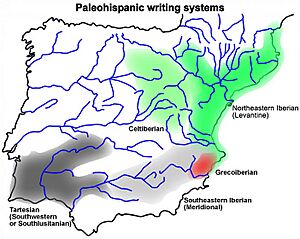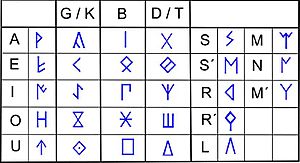Northeastern Iberian script facts for kids
The Northeastern Iberian script was the main way people wrote the Iberian language long ago. You might also hear it called Levantine Iberian or just Iberian script. Interestingly, it was also used to write an early form of the Basque language, like on the famous Hand of Irulegi.
The Iberian language could also be written using the southeastern Iberian script and the Greco-Iberian alphabet. The Northeastern and Southeastern Iberian scripts look different, and their signs have different meanings. However, experts believe they came from the same original writing system. Many think the Northeastern script developed from the Southeastern script. Some researchers believe it was influenced only by the Phoenician alphabet, while others think the Greek alphabet also played a part.
Contents
How the Script Works: A Mixed System
Most ancient scripts from the Iberian Peninsula, called paleohispanic scripts, are special. They are not true alphabets (where each letter is a sound) or true syllabaries (where each sign is a syllable). Instead, they are a mix, often called semi-syllabaries.
This means that for some sounds, like "p," "t," or "k" (called occlusives), the script uses signs that stand for a whole syllable, like "pa," "te," or "ki." For other sounds, like vowels (a, e, i, o, u) and most other consonants, each sign represents just one sound.
The basic Northeastern Iberian script has 28 signs:
- 5 signs for vowels (a, e, i, o, u).
- 15 signs for syllables (like "ba," "be," "bi," "bo," "bu").
- 8 signs for other consonants (like "l," "s," "r," "n").
Unlocking the Secrets: Deciphering the Script
The Northeastern Iberian script was mostly figured out in 1922 by a smart person named Manuel Gómez-Moreno Martínez. He carefully matched the syllable signs to their sounds. He did this by looking at many ancient coins. Some of these coins had both Iberian writing and Latin writing. By comparing the names on the coins to old Roman and Greek place names, he could work out what many of the signs meant.
Two Main Types of Northeastern Iberian Script
There are two main versions, or "variants," of the Northeastern Iberian script:
The Dual Variant
This version was used mostly for older writings, from the 4th and 3rd centuries BCE (that's about 2,300 to 2,400 years ago!). Its special feature is a "dual system." This system was discovered by Joan Maluquer de Motes in 1968. It helped people tell the difference between similar sounds, like "b" (voiced) and "p" (unvoiced), or "g" (voiced) and "k" (unvoiced).
How did it work? For these specific sounds, a simple sign meant the "voiced" sound (like 'b'). A slightly more complex sign, often with an extra stroke, meant the "unvoiced" sound (like 'p').
The Non-Dual Variant
This version was used for more recent writings, from the 2nd and 1st centuries BCE (about 2,000 to 2,200 years ago). This variant did not use the special "dual system" to show voiced and unvoiced sounds.
Where We Find These Writings
Most of the writings using the Northeastern Iberian script have been found in the northeastern part of the Iberian Peninsula. This includes areas along the coast from Roussillon (in modern-day France) down to Alicante (in Spain). They are also found deep inland in the Ebro Valley.
These ancient writings appear on many different kinds of objects:
- silver and bronze coins
- Silver and ceramic bowls or containers
- lead plaques (flat pieces of lead)
- mosaics (pictures made from small colored pieces)
- amphoras (large storage jars)
- Stones, including steles (upright stone slabs)
- spindle-whorls (weights used in spinning thread)
In fact, over 2,000 items with this script have been found, making up about 95% of all ancient Iberian writings! Almost all of them are written from left to right.
The oldest Northeastern Iberian writings date back to the 4th or even 5th century BCE. The newest ones are from the very end of the 1st century BCE or the beginning of the 1st century CE.
In recent years, four special "abecedaries" or "signaries" (like alphabet charts) of the Northeastern Iberian script have been found and studied. These include the Castellet de Bernabé signary, the Tos Pelat signary, the Ger signary, and the Bolvir signary. All of these belong to the older, dual variant of the script.
See also
 In Spanish: Escritura ibérica nororiental para niños
In Spanish: Escritura ibérica nororiental para niños
- Greco-Iberian alphabet
- Iberian scripts
- Paleohispanic scripts
- Paleohispanic languages
- Pre-Roman peoples of the Iberian Peninsula







